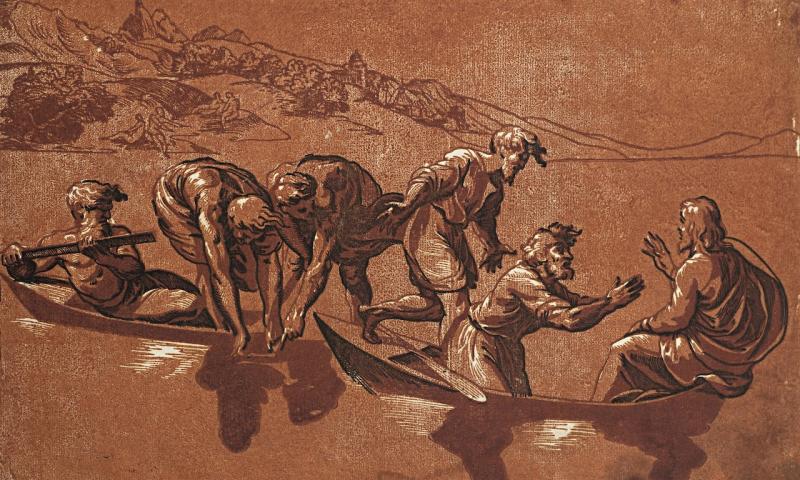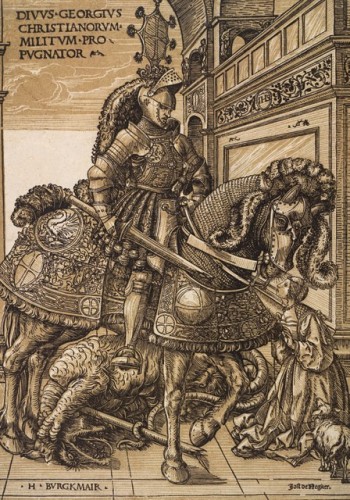Renaissance Impressions, Royal Academy | reviews, news & interviews
Renaissance Impressions, Royal Academy
Renaissance Impressions, Royal Academy
Georg Baselitz’s extraordinary collection of 16th-century woodcut prints

Georg Baselitz might seem an unlikely connoisseur of 16th-century prints, but since the Sixties the controversial German artist has amassed a collection of chiaroscuro woodcuts to rival that of any museum.
Supplemented by loans from the Albertina, Vienna, Baselitz’s extraordinary collection follows the progress of the chiaroscuro woodcut from its invention in Germany through its rapid development across Italy and the Netherlands. Both Lucas Cranach and Hans Burgkmair the Elder claimed credit for the invention and Burgkmair’s portrait of Hans Paumgartner, 1512, demonstrates the capacity of the medium to render texture and volume, the luxuriant, hazy softness of Paumgartner’s fur collar captured entirely with line and tone.
 Cranach and Burgkmair each produced chiaroscuro woodcuts dated 1508, Burgkmair’s St George and the Dragon, c.1508-10 (pictured left), using a key block with which the black lines were printed, and a single tone block coloured with a light brown ink. Far from simply adding colour to a monochrome image, the tone block creates highlights and mid tones which add depth and form to the modelling. Significant areas of the paper are left white, and it is this use of highlights that really defines the chiaroscuro – light and shade – woodcut technique.
Cranach and Burgkmair each produced chiaroscuro woodcuts dated 1508, Burgkmair’s St George and the Dragon, c.1508-10 (pictured left), using a key block with which the black lines were printed, and a single tone block coloured with a light brown ink. Far from simply adding colour to a monochrome image, the tone block creates highlights and mid tones which add depth and form to the modelling. Significant areas of the paper are left white, and it is this use of highlights that really defines the chiaroscuro – light and shade – woodcut technique.
It is perhaps not surprising that Dürer, the great printmaker of the time, remained unmoved by this innovation, concluding, rightly enough, that he had no need of colour when he could perfectly well express all that he wanted with black lines alone. Indeed, after Dürer’s death in 1528, Erasmus eulogised: "Dürer, though admirable also in other respects, what does he not express in monochromes, that is, in black lines. Light, shade, splendour, eminences, depressions". Dürer knew how to make minute tonal gradations within a single block, and in many ways, his fellow printmakers were using the chiaroscuro technique simply to emulate Dürer’s finesse, using the tone block to enhance an essentially linear design.
The painter and woodcutter Ugo da Carpi introduced chiaroscuro woodcut to Italy, and it was he who unlocked the painterly qualities of the form, recognising that the tone block could have a purpose beyond complementing the lines of the key block. Ugo’s print after a drawing by Raphael, The Miraculous Draught of Fishes, 1523-27 (main picture), uses three blocks; the two tone blocks use gradations of red, one of which is boldly printed across the entire sheet, while the black is kept to a minimum, providing accents and occasional areas of deep shadow. Bright white highlights add to the sense of movement and vigour, and the print has all the immediacy and panache of a sketch.
 Some of Ugo’s prints are here in different states, and it is fascinating to see how he and his pupils would reprint an image, using different tones to explore the effects of light and shade. Like Ugo, two of his pupils, Antonio da Trento and Niccolò Vicentino, translated drawings by Parmigianino into print form. The way that these two worked, often producing prints of the same drawing, not only reveals something of the workings of Parmigianino’s workshop, but shows how differently the same drawing could be interpreted by individual woodcutters. Antonio da Trento’s chiaroscuro woodcut of Augustus and the Tiburtine Sibyll, c.1529-30, is shown next to Vicentino’s treatment of the same drawing, but where da Trento’s print is graphic and linear, Vicentino’s print is fluid and painterly, and it is interesting to imagine how Parmigianino may have enjoyed the variety of interpretations given to his drawings. (Pictured right: Hendrick Goltzius, Bacchus, c.1589-90.)
Some of Ugo’s prints are here in different states, and it is fascinating to see how he and his pupils would reprint an image, using different tones to explore the effects of light and shade. Like Ugo, two of his pupils, Antonio da Trento and Niccolò Vicentino, translated drawings by Parmigianino into print form. The way that these two worked, often producing prints of the same drawing, not only reveals something of the workings of Parmigianino’s workshop, but shows how differently the same drawing could be interpreted by individual woodcutters. Antonio da Trento’s chiaroscuro woodcut of Augustus and the Tiburtine Sibyll, c.1529-30, is shown next to Vicentino’s treatment of the same drawing, but where da Trento’s print is graphic and linear, Vicentino’s print is fluid and painterly, and it is interesting to imagine how Parmigianino may have enjoyed the variety of interpretations given to his drawings. (Pictured right: Hendrick Goltzius, Bacchus, c.1589-90.)
Back in Germany, Erasmus Loy was developing the chiaroscuro woodcut in quite a different direction, using the tone blocks to dramatic effect in graphic architectural views, like Courtyard with Renaissance Architecture, c. 1550. These prints were sold as wallpaper that could be pasted onto walls and furniture as a cheap alternative to marquetry, the bold arrangements of black, brown and highlights mimicking the effects of inlaid wood.
That focusing on such a specific area of printmaking can produce a wide-reaching and varied exhibition only emphasises the scale and quality of artistic activity in Renaissance Europe. Works by Domenico Beccafumi and Andrea Andreani give some insight into the ambitions of Italian printmaking of the 16th century, while chiaroscuro woodcuts by Hendrick Goltzius show the technique used to create atmospheric landscapes that explore the effects of light in conditions ranging from bright sunshine to a brewing storm. The exhibition’s narrow focus risks seeming arcane, but actually serves to elucidate just some of the preoccupations and practices of artists in this golden age of printmaking.
Explore topics
Share this article
The future of Arts Journalism
You can stop theartsdesk.com closing!
We urgently need financing to survive. Our fundraising drive has thus far raised £49,000 but we need to reach £100,000 or we will be forced to close. Please contribute here: https://gofund.me/c3f6033d
And if you can forward this information to anyone who might assist, we’d be grateful.

Subscribe to theartsdesk.com
Thank you for continuing to read our work on theartsdesk.com. For unlimited access to every article in its entirety, including our archive of more than 15,000 pieces, we're asking for £5 per month or £40 per year. We feel it's a very good deal, and hope you do too.
To take a subscription now simply click here.
And if you're looking for that extra gift for a friend or family member, why not treat them to a theartsdesk.com gift subscription?
more Visual arts
 'We are bowled over!' Thank you for your messages of love and support
Much-appreciated words of commendation from readers and the cultural community
'We are bowled over!' Thank you for your messages of love and support
Much-appreciated words of commendation from readers and the cultural community
 Folkestone Triennial 2025 - landscape, seascape, art lovers' escape
Locally rooted festival brings home many but not all global concerns
Folkestone Triennial 2025 - landscape, seascape, art lovers' escape
Locally rooted festival brings home many but not all global concerns
 Sir Brian Clarke (1953-2025) - a personal tribute
Remembering an artist with a gift for the transcendent
Sir Brian Clarke (1953-2025) - a personal tribute
Remembering an artist with a gift for the transcendent
 Emily Kam Kngwarray, Tate Modern review - glimpses of another world
Pictures that are an affirmation of belonging
Emily Kam Kngwarray, Tate Modern review - glimpses of another world
Pictures that are an affirmation of belonging
 Kiefer / Van Gogh, Royal Academy review - a pairing of opposites
Small scale intensity meets large scale melodrama
Kiefer / Van Gogh, Royal Academy review - a pairing of opposites
Small scale intensity meets large scale melodrama
 Jenny Saville: The Anatomy of Painting, National Portrait Gallery review - a protégé losing her way
A brilliant painter in search of a worthwhile subject
Jenny Saville: The Anatomy of Painting, National Portrait Gallery review - a protégé losing her way
A brilliant painter in search of a worthwhile subject
 Abstract Erotic, Courtauld Gallery review - sculpture that is sensuous, funny and subversive
Testing the boundaries of good taste, and winning
Abstract Erotic, Courtauld Gallery review - sculpture that is sensuous, funny and subversive
Testing the boundaries of good taste, and winning
 Edward Burra, Tate Britain review - watercolour made mainstream
Social satire with a nasty bite
Edward Burra, Tate Britain review - watercolour made mainstream
Social satire with a nasty bite
 Ithell Colquhoun, Tate Britain review - revelations of a weird and wonderful world
Emanations from the unconscious
Ithell Colquhoun, Tate Britain review - revelations of a weird and wonderful world
Emanations from the unconscious
 Rachel Jones: Gated Canyons, Dulwich Picture Gallery review - teeth with a real bite
Mouths have never looked so good
Rachel Jones: Gated Canyons, Dulwich Picture Gallery review - teeth with a real bite
Mouths have never looked so good
 Yoshitomo Nara, Hayward Gallery review - sickeningly cute kids
How to make millions out of kitsch
Yoshitomo Nara, Hayward Gallery review - sickeningly cute kids
How to make millions out of kitsch
 Hamad Butt: Apprehensions, Whitechapel Gallery review - cool, calm and potentially lethal
The YBA who didn’t have time to become a household name
Hamad Butt: Apprehensions, Whitechapel Gallery review - cool, calm and potentially lethal
The YBA who didn’t have time to become a household name

Add comment